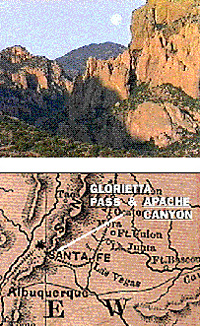 Glorietta Pass today
Glorietta Pass today
When the Confederacy seceded from the Union, it had plans, which they felt could sustain them through a war. The plans seemed flawless, having commodities necessary to the nations of Europe, however they soon learned that their initial plan would not be successful unless trade could be maintained. As the North began blockading the South's ports, effectively hindering trade, visionary Henry Sibley proposed a plan that could have changed the course of the war. Sibley had been stationed in the west prior to the outbreak of the war.
From his knowledge of the area and present conditions, Sibley realized that the key to the south winning the war was through the conquering of the west. This action would have two benefits; the first would be to bring gold to the South from Colorado and California. The second would be to establish seaports on the western coast, free from blockade. The main problem facing Sibley was that most men and supplies were being used on the East Coast. He had to propose his plan be done as cheaply as possible to have it approved. Combining this with family ties, sickness, the unheard of element of altitude sickness, and the extraordinary luck of a preacher turned soldier, the action was doomed for failure. The battle at Glorietta Pass proved to be the end of General Sibley's plan, and was the turning point of the Civil War.
The southern states seceded from the Union due to economic and political conditions. The North was the base of political and economic power in the United States. It had factories, government, and a large fleet, creating a significant offset of wealth and power. The South had depended on slave labor, a cheaper form of production, for their two major crops, cotton and tobacco. Both these products had a large following throughout the world, and the South felt that utilizing these products would make them strong enough to establish a separate nation.
The Civil War officially began April 12, 1861 with the firing on Fort Sumter. Before this James H. Hammond of South Carolina told the U.S. Senate, "without firing a gun, without drawing a sword, should they make war on us we could bring the whole world to our feet. You dare not make war on cotton. No power on earth dares to make war upon it. Cotton is King!"
The South believed that the countries of Europe would rally behind them, abandoning the Union. Their initial tactic was to hold back shipments of cotton, driving up price and demand.
There were several flaws with this strategy, the first being a stockpile of cotton in Europe, which was unknown to the South. The second was President Abraham Lincoln immediately initiating the blockade of Southern ports. The South had known this would happen, but not as quickly as President Lincoln initiated it. The first years of the blockade were largely unsuccessful, as the North built up it's fleet, however in the latter years the North had enough ships to make the blockade effective. Virtually all southern ports became worthless.
The U.S. Army had approximately seventy percent of its manpower stationed in the West at the war's outbreak. As the Civil War was being fought in the East, supplies and manpower were constantly being drained from the West. The West was of little concern to the Union, the situation growing continuously worse as officers and soldiers left the U.S. Army, taking arms and supplies with them.
New Mexico had Forts McLane, Thorn, Craig, Fillmore and Bliss on the Rio Grande. Fort Union was near Las Vegas, and Fort Marcy was at Santa Fe. Fort Stanton was in the Lincoln Mountains, and Fort Defiance was located centrally on the Arizona border. Forts Breckenridge and Buchanan were near Tucson, Arizona. Within six months after the start of the war, the Confederates had Forts Bliss, Breckenridge, Buchanan, and Fillmore. Forts Marcy, Stanton, and Defiance were abandoned due to manpower shortages, and by 1862 the North had only Fort Craig and Fort Union. Such was the decaying condition of the U.S. presence in the West.
More Glorietta Pass
Back to Cry Havoc #31 Table of Contents
Back to Cry Havoc List of Issues
Back to MagWeb Master Magazine List
© Copyright 2000 by David W. Tschanz.
This article appears in MagWeb (Magazine Web) on the Internet World Wide Web. Other military history articles and gaming articles are available at http://www.magweb.com